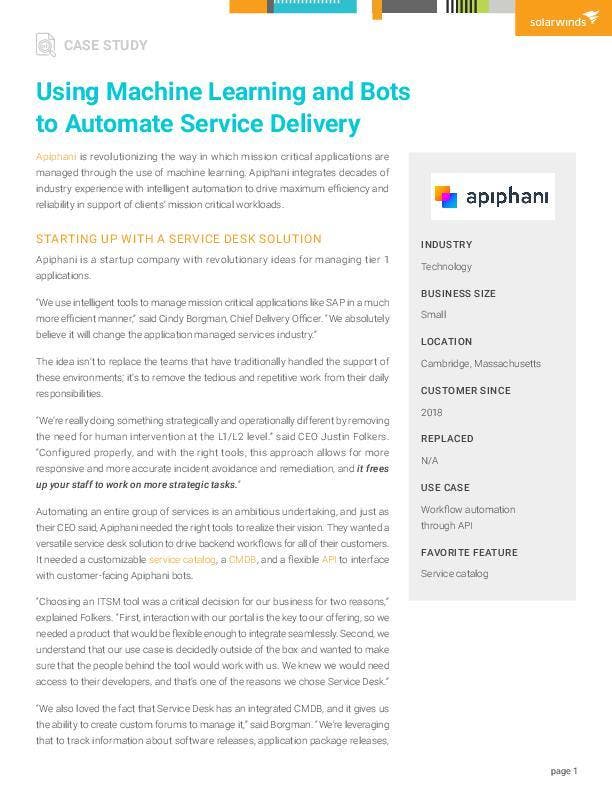Using Machine Learning and Bots to Automate Service Delivery
Samanage is now SolarWinds® Service Desk.
Starting Up with a Service Desk Solution
Apiphani is a startup company with revolutionary ideas for managing tier 1 applications. “We use intelligent tools to manage mission critical applications like SAP in a much more efficient manner,” said Cindy Borgman, Chief Delivery Officer. “We absolutely believe it will change the application managed services industry.” The idea isn’t to replace the teams that have traditionally handled the support of these environments; it’s to remove the tedious and repetitive work from their daily responsibilities. “We're really doing something strategically and operationally different by removing the need for human intervention at the L1/L2 level,” said CEO Justin Folkers. “Configured properly, and with the right tools, this approach allows for more responsive and more accurate incident avoidance and remediation, and it frees up your staff to work on more strategic tasks.” Automating an entire group of services is an ambitious undertaking, and just as their CEO said, Apiphani needed the right tools to realize their vision. They wanted a versatile service desk solution to drive backend workflows for all of their customers. It needed a customizable service catalog, a CMDB, and a flexible API to interface with customer-facing Apiphani bots. “Choosing an ITSM tool was a critical decision for our business for two reasons,” explained Folkers. “First, interaction with our portal is the key to our offering, so we needed a product that would be flexible enough to integrate seamlessly. Second, we understand that our use case is decidedly outside of the box and wanted to make sure that the people behind the tool would work with us. We knew we would need access to their developers, and that’s one of the reasons we chose Samanage.” “We also loved the fact that Samanage has an integrated CMDB, and it gives us the ability to create custom forums to manage it,” said Borgman. “We're leveraging that to track information about software releases, application package releases, patching releases, all of which we leverage to identify trends in both health and stability. ServiceNow does include a CMDB, but it's ridiculously expensive, and it's not very flexible.” After settling on the Samanage Service Platform, the Apiphani team set out to make their vision a reality.
Automated Service Delivery Through Machine Learning
Apiphani is building a business around a new service experience. The leadership team believes they can offer a solution that completely removes a time-consuming and risk heavy layer of SAP systems support. “There are a number of inefficiencies in the traditional model, with tickets bouncing around between teams, routing and escalation issues, etc. People invest a lot of resources into controlling those processes,” said Borgman. So how are they addressing those inefficiencies? “Bots and machine learning,” said CTO Nick Rees. “We’ve created a platform that can respond to users’ issues with intelligent interaction. Whether someone is at their desk or on a mobile device on the train, our bot will collect the pertinent data to populate the Samanage ticket through the API. From there, it can take an action, recommend a self-service solution, or kickoff an automated workflow.” “So far we’ve come up with 33 use cases for self-service,” said Borgman. “That means the bot performs an action to update these ‘pre-incident’ tickets that we never need to touch. By using the interface with Samanage, our machines are able to talk back and forth between the front-end toolset and your tickets automatically, which enables us to perform a lot of self-healing actions.” They also use the Samanage service catalog to manage certain requests. “The service catalog is perfect as our services depend on consistency and efficiency,” said Borgman. “If you can automate a workflow, that means it gets done the exact same way every time, which is exactly what we’re looking for.”
Transforming Service with a Partner
It’s not an ordinary service management use case, and the Apiphani team knew that in advance. Whatever solution they chose would need to be flexible both technically and within the development team to help them meet their goals. Apiphani is multi-tenant, so it’s supporting different customers with the same set of technologies. That means they need a versatile feature set to create different triggers for different accounts. Their bot can collect all of the information through smart interaction with the customer, and it can use that data to interact with the service catalog or the knowledge base in Samanage before returning to the customer with a solution. “Obviously, we needed some advanced functionality to make all of that work,” said Rees. “Some people put a wall around their knowledge, but the Samanage developers worked directly with ours, and we successfully implemented the solution with a pretty short runway.” Apiphani has also used the site IDs in Samanage to support different customer needs, creating customized experiences for different accounts. “We know that our use case is different than a majority of the customers who use the application for internal employee services,” said Borgman. “But Samanage has really been a partner in helping us build anything we want with the API calls, and that’s helped us create an ideal experience for our customers.”
More resources similar to this
St Peter’s Prep Schools Selects SolarWinds Service Desk Over Spiceworks, Atlassian, and Zendesk
Learn how a two-person IT department without a formal ticketing solution used SolarWinds Service Desk to improve call response time and aid resource planning.
View Case StudySaber Healthcare Guarantees 99.9% SLA With SolarWinds Service Desk in IT and Over a Dozen Other Departments
Assisted living industry leader reduces software spend and sprawl by expanding SolarWinds Service Desk company-wide.
View Case StudyHomebuilder M/I Homes Reduces Incidents by Nearly 30% With Data Insights
Learn how streamlining ticketing, accelerating troubleshooting, and optimizing issue resolution drives efficiencies throughout the geographically dispersed organization.
View Case Study